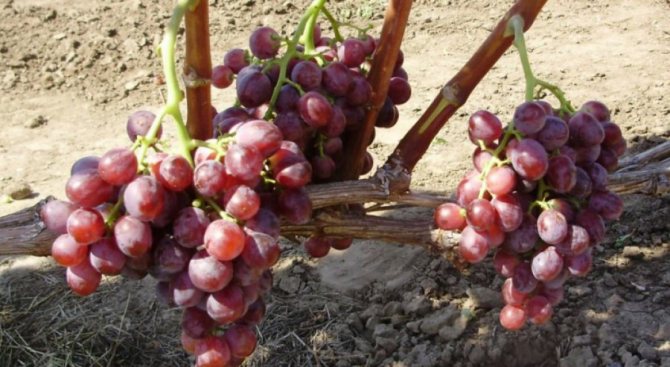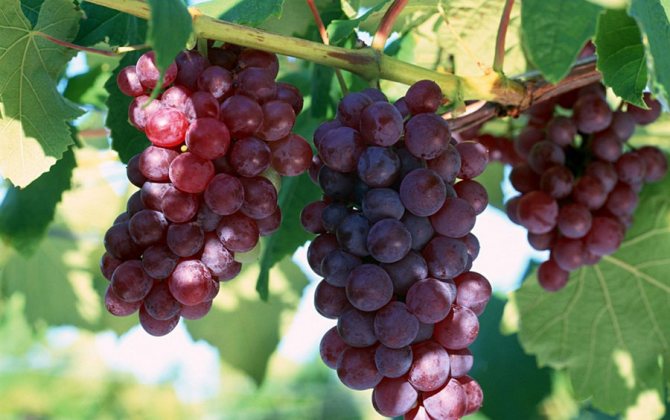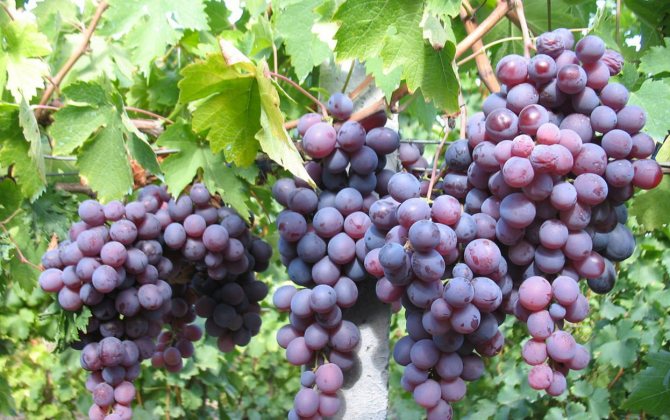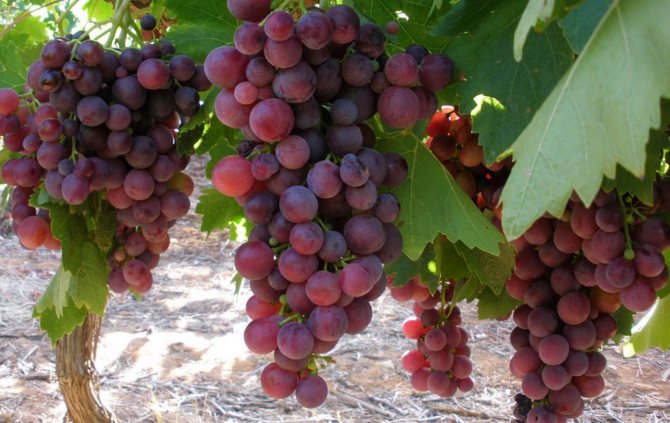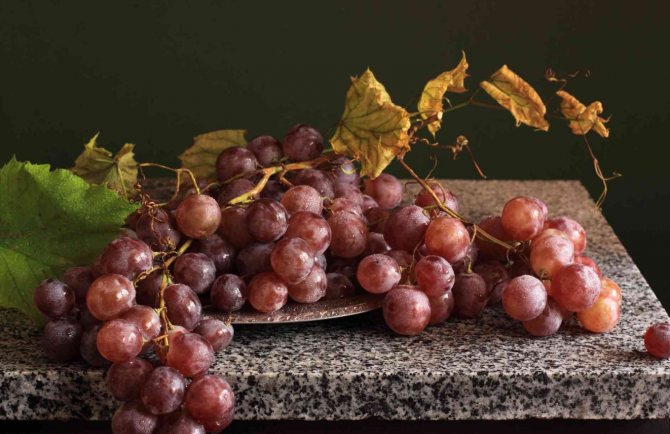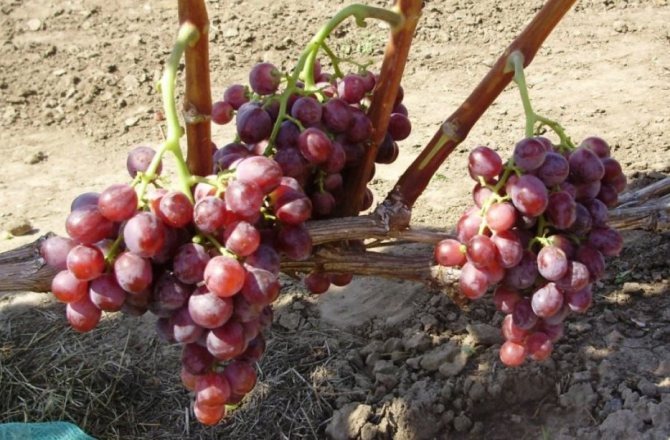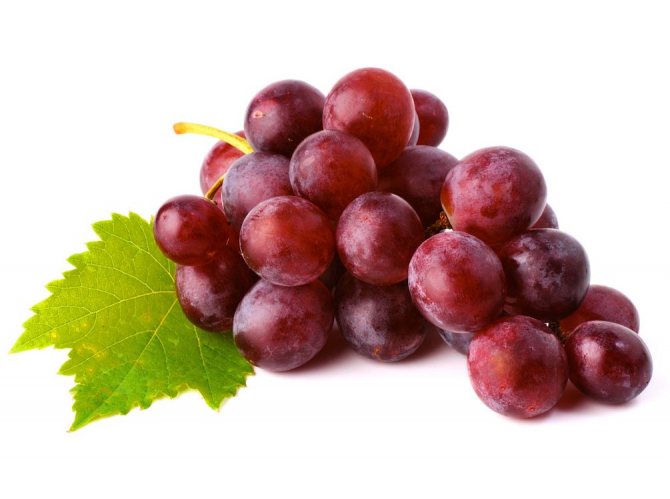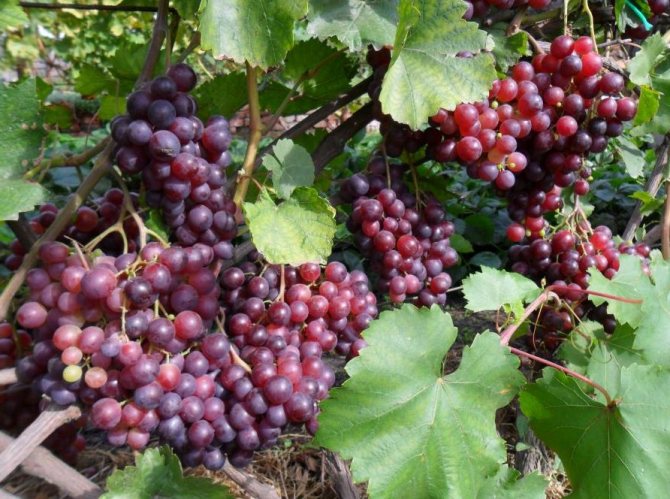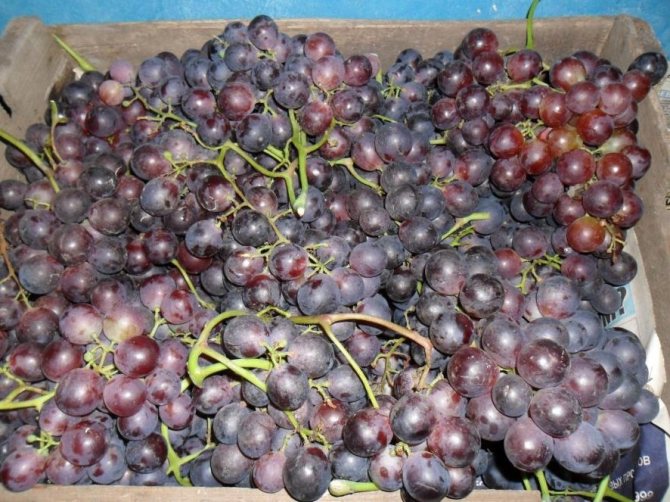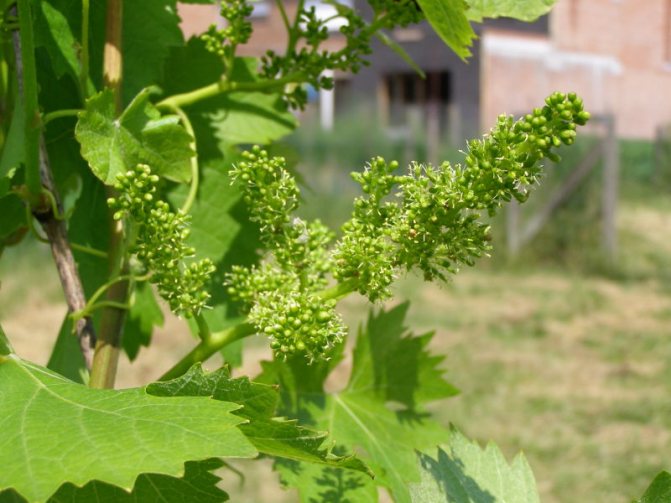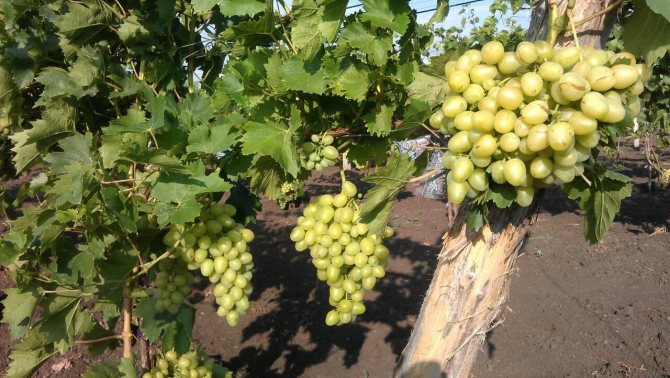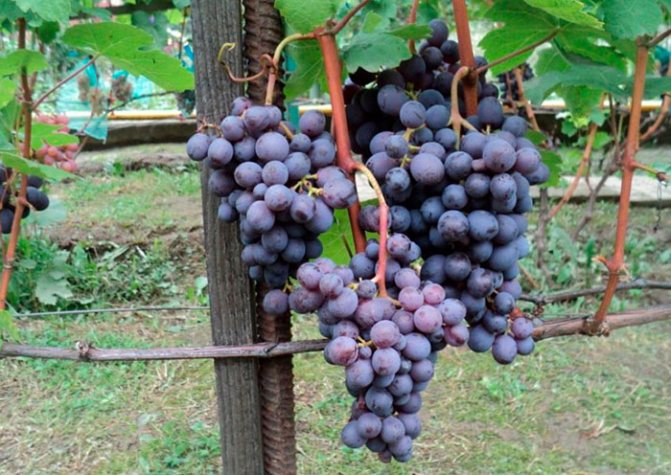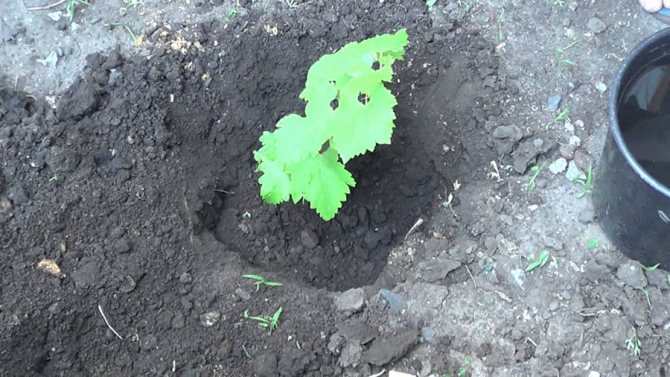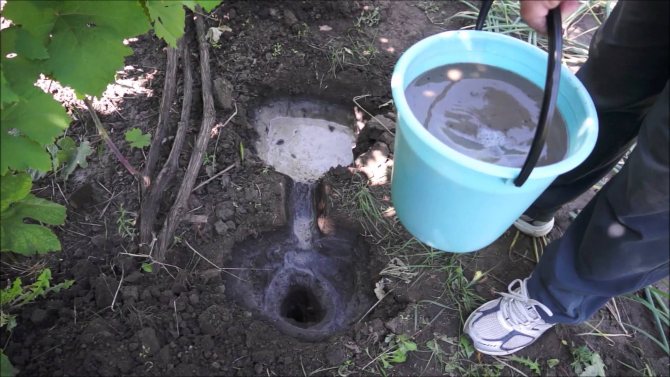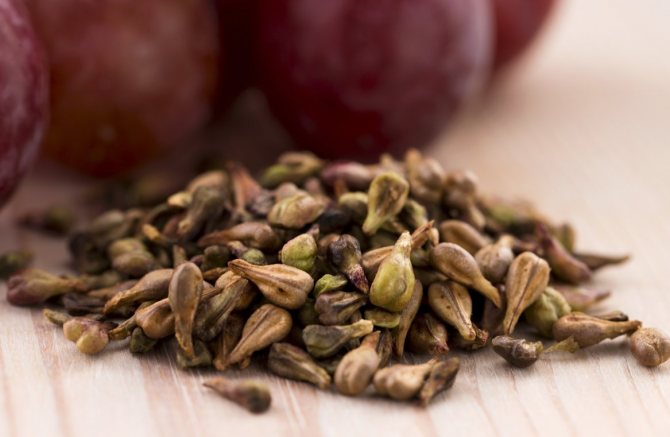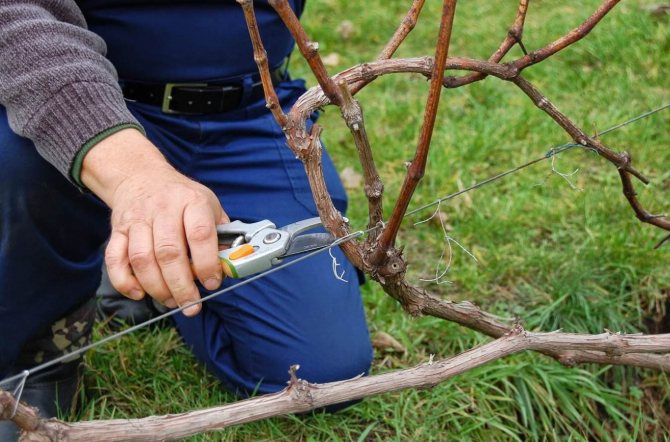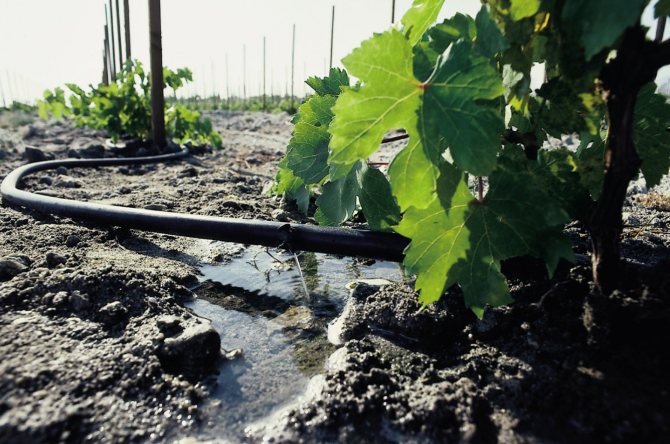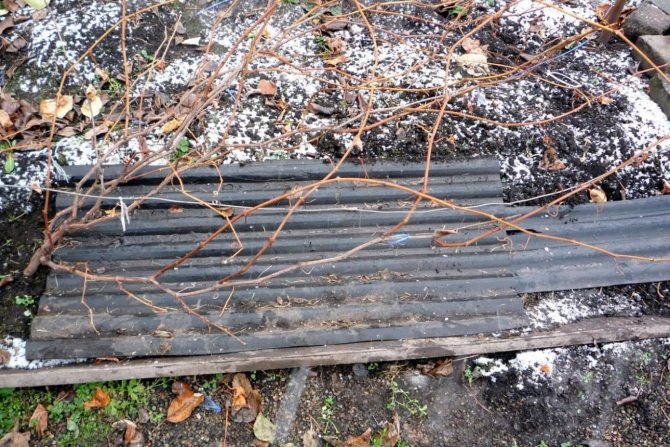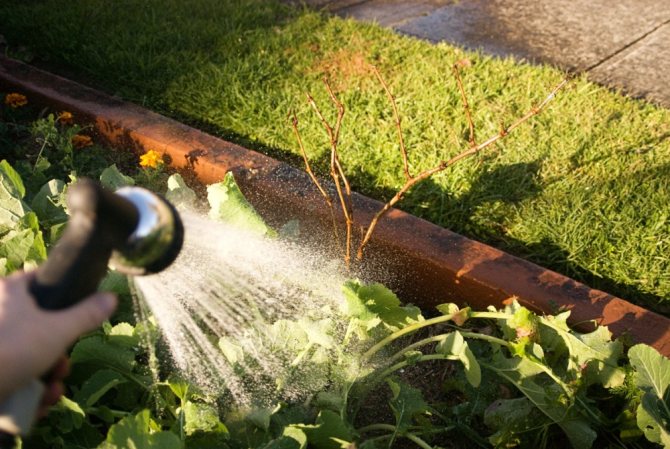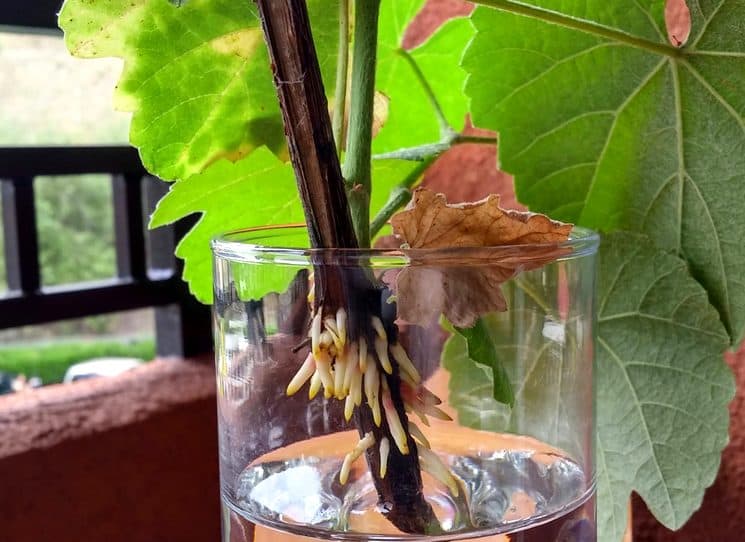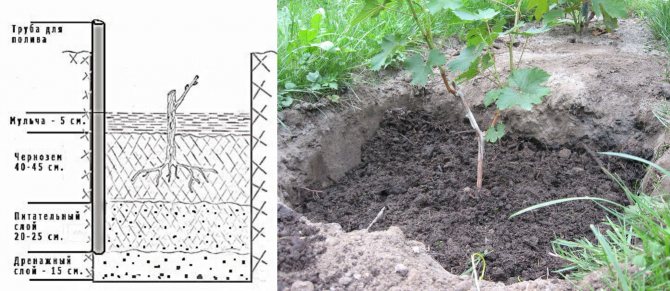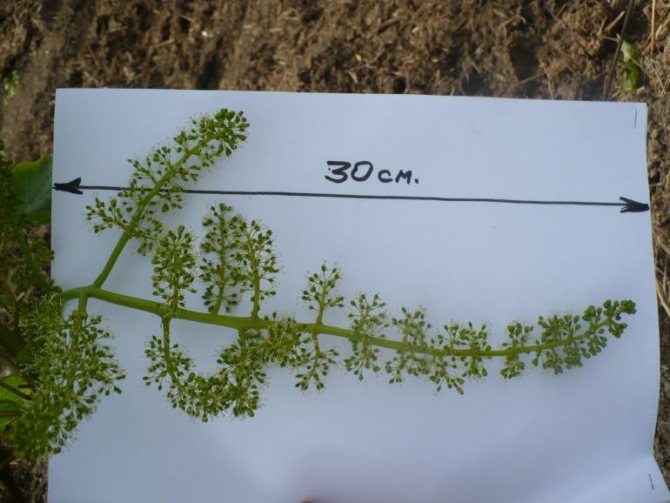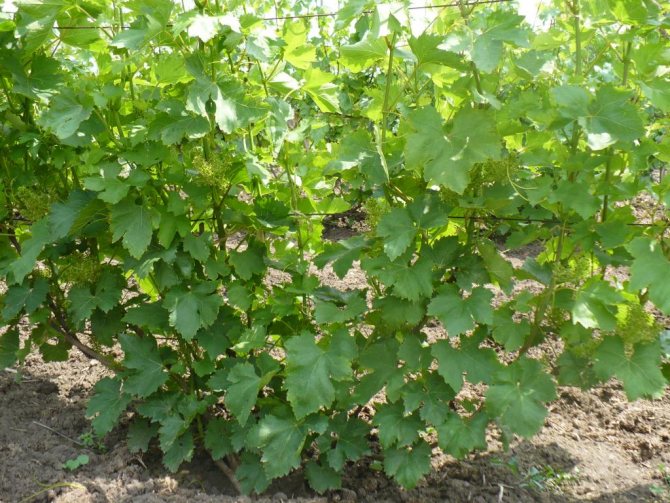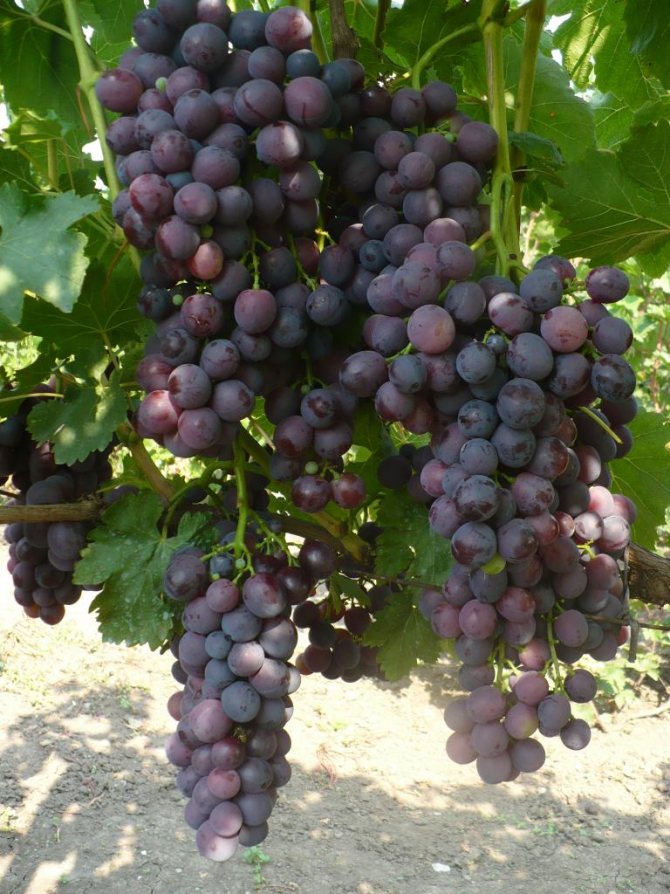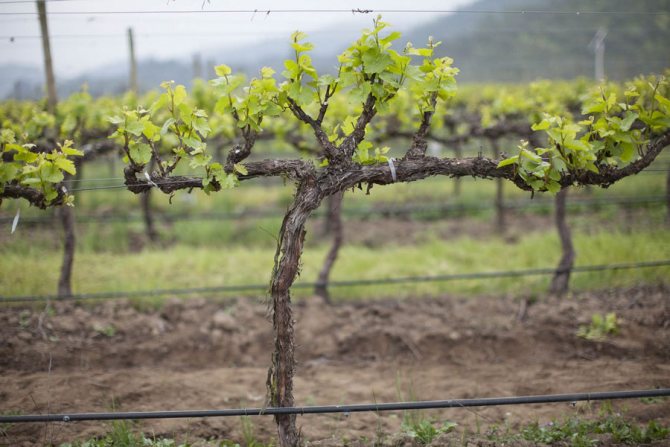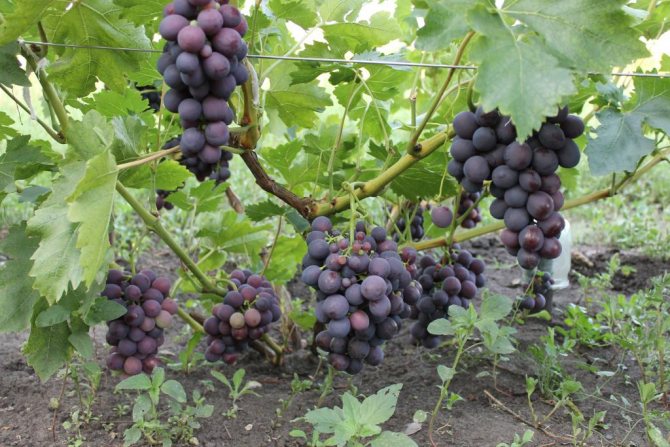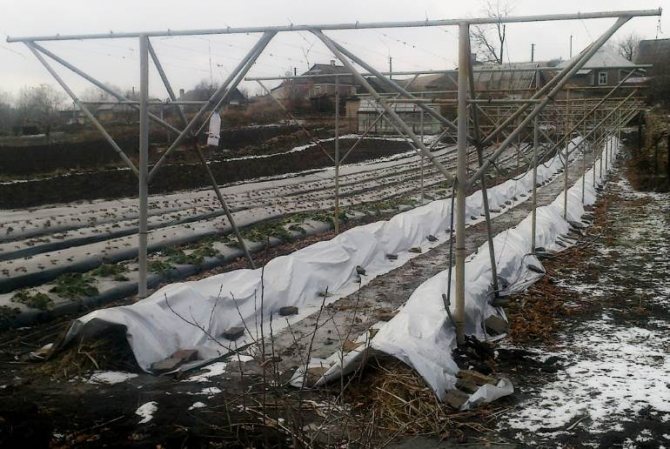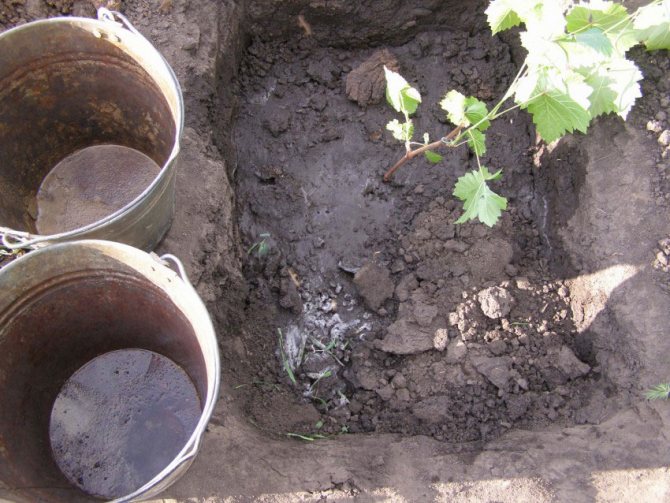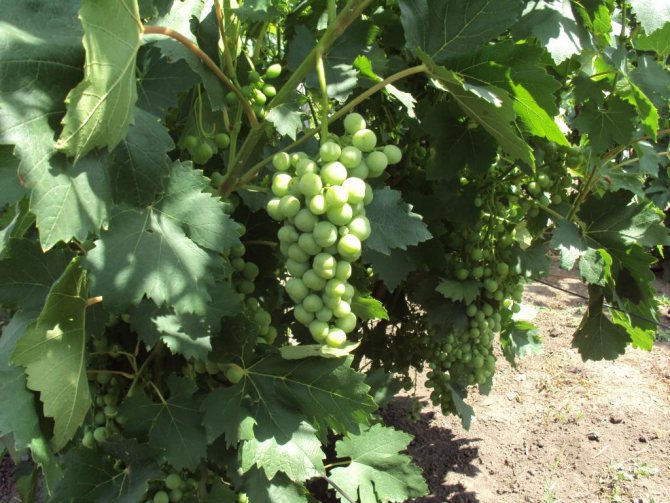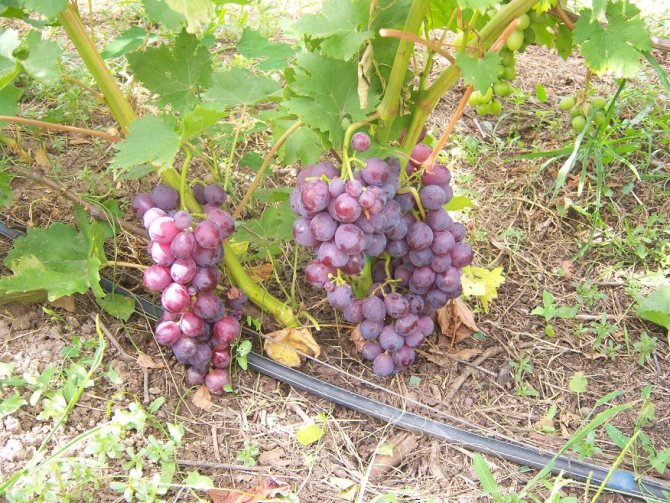The Cardinal grape is an early-ripening table variety that was bred in the United States and then successfully taken root throughout Europe. "Cardinal" ripens quickly, tastes good and shows good yields. It is not the easiest variety in terms of care and protection from diseases and pests. But those who are not afraid of these difficulties will be able to enjoy its extraordinary taste.
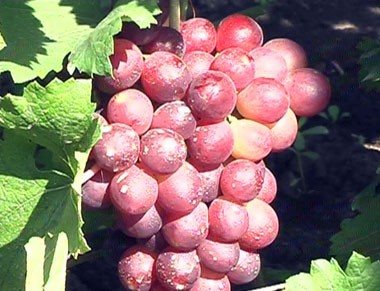
Features and characteristics of the variety
A specific property of the massive bunches of the Black Cardinal is early ripening. The grapes reach ripeness 110-120 days after the start of the growing season, usually in mid-August. The heat-loving vine is distinguished by strong and fast growth under favorable conditions - up to 3 m. The bark of the Cardinal grape variety is of a characteristic bright brown color, darker at the nodes. Large, five-lobed, toothed along the edge of the leaves are light green in spring, then acquire a rich dark shade. The flowers of this variety are bisexual, well pollinated.
Comment! For a guaranteed harvest, some growers additionally carry out powder puff pollination.
Cylindric-conical grape clusters are large - up to 25 cm, in width - up to 15 cm. Loose, on a long stem that easily breaks off the vine, with an average weight of 400 g. On old bushes, the yield is more significant than on young ones. One shoot can produce two clusters of 0.5 kg each. When tasting the fruits of the Cardinal variety, they received an assessment of 8-9 points. They are transportable and can be stored for up to 3 months.
Dark purple or violet-red berries - the difference in description due to the mineral composition of the soil - large, oval, sometimes more rounded, covered with a noticeable waxy bloom. Sometimes they have a beveled top with a groove. The weight of one berry is 6-10 g with sizes up to 1.5-3 cm. The skin is dense, but it is easy to bite through it. The pulp is fleshy, light, pleasant to the taste, with noble notes of nutmeg. The berries of the Cardinal grapes are sweet, with a slight sourness: the sugar content to acid is 2: 1. The sugar index in berries of this variety is up to 18.0 g per 100 ml.
Landing features
The grapes prefer sunny areas, but can also grow in conditions of inconsistent sunlight. This happens if there is a landing site only on the north or east side. In this case, the illumination changes depending on the season and time of day, but sunlight, although not direct, must be there. The soil should be sandy to allow rapid drainage from the roots during rains. If it is not loose enough, then this should be taken into account when preparing the pit for planting. Variety Cardinal grows well on neutral soil with an acidity of 5–7 pH.
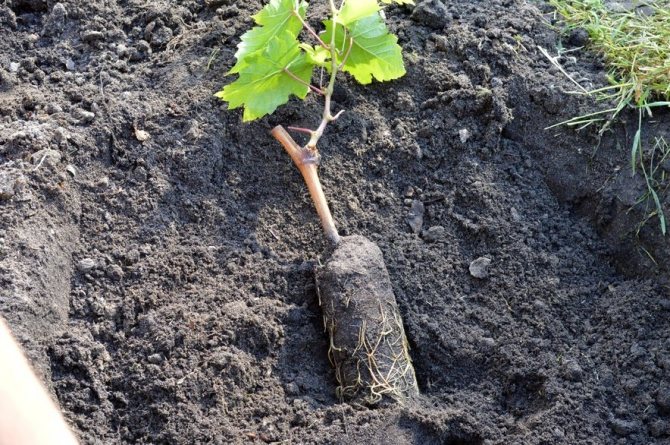

Planting technology for Cardinal grapes:
- Measure the acidity of the soil 2-3 weeks before planting. If the value is above 7 pH, then chalk or dolomite flour should be added to make it neutral.
- Prepare a planting pit measuring 60 × 60 × 60 cm. The shape of the pit should resemble a truncated inverted cone.
- Lay a drainage layer at the bottom of the pit. It can be pebbles, rubble or other material, the task of which is to remove excess moisture from the roots.
- If the soil removed from the pit is loamy, add sand and compost in equal proportions. Mix well and lay on the drain so as to fill the hole by 2/3.
- Pour in a bucket of water.
- If desired, the roots of the cuttings can be treated with a root growth stimulant.
- Place the cutting in the hole and add the remaining soil.
- Press down firmly around the stem. All roots should be well covered with soil.
- You can immediately place a peg for a garter (at least 1.2 m high) or put a trellis next to the handle.
Video: planting grape seedlings
Harvesting and storage
Bunches of cardinal grapes ripen not together, but in parts from about the second decade of August. Harvested in bunches as it ripens. During the collection, you need to pay attention to the condition of the berries. If a branch has a lot of cracked berries, then it is it that needs to be used first.
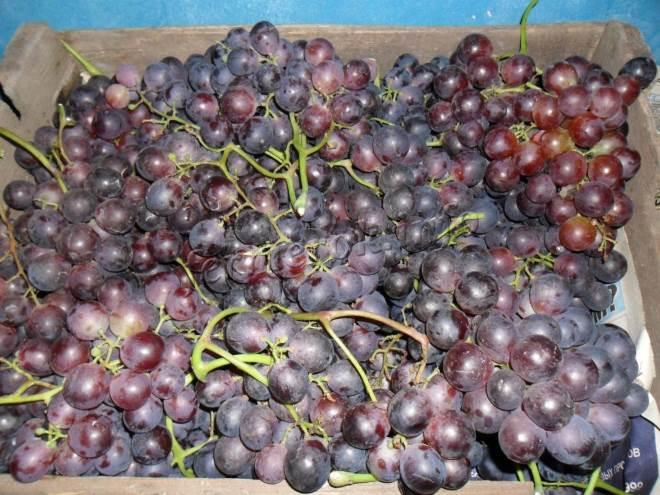

Under favorable growing conditions, Cardinal grapes will delight with their harvest
Important!
Damaged berries can quickly deteriorate, so only exemplary specimens are taken for long-term transportation.
Harvested bunches of Cardinal grapes can be stored well if they are kept under normal conditions. Best of all, they lie in the cool, dark. The place should be isolated from midges and rodents.
Growing recommendations
Adhering to the general rules for growing grapes for the Cardinal is not enough, you need to constantly monitor the conditions in which the culture grows. As already mentioned, in the space of the former USSR, it is suitable for growing only in a few regions, since it is thermophilic. Choose a sunny open area for planting Cardinal grapes, chernozems are best suited, as the richest soils, but you can also grow on light loam or sandy loam soils (the temperature during planting should be below 10 degrees). But you can't do without additional feeding - it is better to use potassium-phosphorus fertilizers from mineral fertilizers. Do not forget to mulch with humus at least once a year (and since Cardinal grapes are very picky about the conditions, it is better to mulch in spring and autumn).
For the Cardinal, as a rule, 2 types of shaping are used: fan-shaped and the Guyot method. It doesn't matter which one you choose, but make sure that the load on one bush does not exceed the limit of 30 eyes, and there are about 13-15 fruitful shoots. To avoid the death of plants in winter, it must be carefully prepared for wintering. Remember that the strain is not very stable. Therefore, without waiting for the appearance of diseases, carry out preventive spraying.
Industrial production of Cardinal grapes is established only in warm regions, but for their own needs it can be grown in other regions where climatic conditions are more severe, the main thing is to pay a lot of attention to plant care. We hope that the description of the characteristics of the Cardinal and the features of agricultural technology will help you grow an excellent table variety.
Advantages and disadvantages of early maturing grapes
When choosing a grape variety for their garden, everyone thinks about the merits of the bush and decides whether the harvest is worth the labor.
- The Cardinal grapes have an advantage in early maturity and large-fruited;
- Berries have an increased sugar content and an amazing taste;
- With good care, high yields are guaranteed;
- Berries are suitable for transportation and are stored for a long time.
There are also negative touches.
- The Cardinal vine is susceptible to the rapid spread of disease. In autumn, its tops are often affected by mildew, oidium, bacterial cancer, so prevention is necessary;
- In rainy weather, the berries can be covered with gray rot;
- The berries ripen on bunches uncommonly. To solve the problem, it is necessary to carry out timely processing with iron sulfate.
Advice! Iron vitriol contributes to the development of the grape bush.
Spraying enriches the plant with iron. The shoots grow more often and become more powerful, respectively, the yield increases. The berries will be large and healthy, without peas.
Diseases and pests
One of the Cardinal's problems is his infection with fungal diseases and pests. Information on diseases of the variety is presented in the table:
| View | Description | Protection |
| Gray rot | It affects inflorescences and fruits. The flowers turn brown and fall. The fruits are covered with a gray bloom. The fungus hibernates inside the bark. | Prevention: good illumination, air access. Treatment with potassium iodide, foundationol or Topaz. |
| Bacterial cancer | The formation of thickenings and growths on the roots and in the table, which impede the supply of nutrients. | The main method of control is preventive measures. If the grapes are weakly infected, the tumors are cut off and the cut is processed, if it is strong, the bush is removed and burned. |
| Downy mildew (mildew) | Oily spots on the upper part of the leaf plate and white spiderweb bloom on the back and on the inflorescences. Brown spots on the vine. | For protection, they are treated with Bordeaux mixture at the beginning of the growing season. Then 3 more times at intervals of 1 time per week. |
| Oidium | The leaves look like floured palms, the berries crack and begin to smell like rot. | They are treated with Raek, Skor and other fungicides. |
| Bunchy leaflet | Cobwebs around flowers and berries that stop developing. Caterpillars develop from eggs and eat leaves. | Preparation for treating Engio caterpillars, collecting insects. |
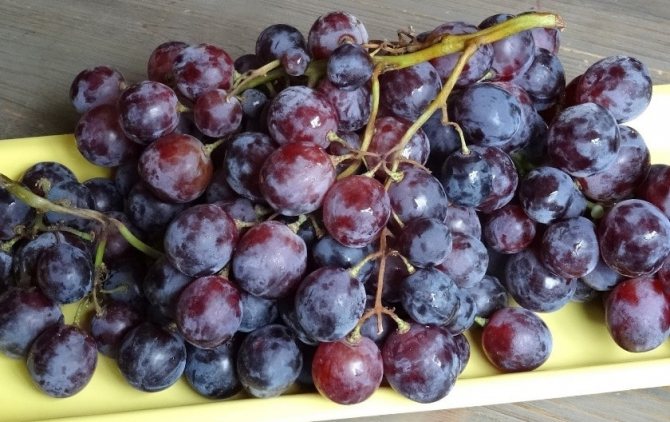

When describing the Cardinal grape variety, we mentioned several times that it needs good care. If you are able to provide it, then the photos of the bunches and the reviews of your friends when you please them with jam will certainly delight you. With good care, you can get a large harvest.
Advantages and disadvantages
Like other grape varieties, Cardinal has strengths and weaknesses. The advantages of grapes are its main secrets:
- large attractive fruits;
- the harvest is stored for 3 months;
- the taste of berries is assessed by professionals on a 9 on a 10-point scale;
- bunches tolerate transportation well;
- high yields are achieved with optimal care.
High yield of grapes "Cardinal" - the fruit of hard work, because it is one of the unstable and demanding varieties.
Cons of grapes "Cardinal:
- susceptible to disease;
- under bad climatic conditions, harvesting suffers: flowers fall, the ovary of grapes is destroyed;
- low resistance to subzero temperatures: the Cardinal begins to bloom early, and frost affects it in the spring.
In addition, this variety ripens unevenly.
What are the beneficial properties of red grapes and how it differs from green and black varieties. You can read about the benefits of grapes for women here.
Description of the variety
Cardinal is a grape of American origin that first came to our region in the middle of the 20th century, when it was brought to the USSR from France. Most suitable for growing in warm regions - the south of Moldova and Ukraine, Krasnodar Territory. It belongs to the early varieties, ripens in 115-120 days, that is, approximately in the second decade of August. The yield of Cardinal grapes is potentially high, but not sustainable, since it is very dependent on the conditions of crop care, the main drawback is the uneven ripening of Cardinal berries. The number of fruitful shoots on the bush is 65-70, and the number of bunches on a developed shoot is about 1.1-1.4.
The bunch of Cardinal grapes is rather large (the length is about 25-30 cm, and the width is 15-20 cm), but not heavy - the average weight is 350-500 g. It is loose or very loose, has a cylindrical-conical shape. Medium-sized oval or round-oval berries, each weighing 5-7 g, contains 3-4 seeds inside. The color of the berries is very attractive - purple-red, with a smoky waxy bloom. The pulp is juicy, green-white, crispy, the skin is dense. The taste of Cardinal grapes is very pleasant (it is not for nothing that it is a table variety!), There is a light nutmeg aroma.The sugar content of the Cardinal at the time of harvest reaches 16-18%, the acidity does not exceed 7-8 hl. The variety is not very resistant to diseases, most often the variety is prone to mildew, gray rot. This is explained by the inability of this overseas variety to our climatic conditions. The situation is similar with frost resistance, in winter it requires shelter. But it is distinguished by excellent transportability and satisfactory keeping quality, as for such demanding grapes.
Planting and caring for a grape bush
The Cardinal grape variety reproduces well by grafting and layering. If the rootstock is strong, the berries will be larger. Propagated by cuttings in the spring, using cut shoots. Autumn planting is preferable; care consists in a thorough shelter for the winter. One should seriously approach the choice of a place for a seedling of Cardinal grapes. It can only be in a southern direction, sunny, with good soil. The bush of this variety prefers black soil, but it grows on other soils.
Attention! When planning a planting site for a Cardinal grape seedling, it is necessary to take into account that varieties that are unstable to diseases do not grow nearby.
- Grape bushes are moisture-loving, but watering needs to be regulated: excess moisture leads to cracking and decay of the berries. Timely drainage will come to the rescue. The vine needs moisture when buds and ovaries appear;
- In autumn and spring, it is obligatory to mulch the Cardinal grape bushes with compost or humus. Complex fertilizers are applied before and after flowering;
- Due to the instability to disease, the valuable vine must be treated with fungicides (colloidal sulfur, Ridomil and others);
- Vines of this variety tolerate short cuttings normally. From three to six eyes are left on the shoot;
- In late autumn, before frost, the Cardinal grape bushes are carefully covered with mulch, straw, hay.
So that the Cardinal grows and pleases you
The best option for cultivating Cardinal is a climate with not very cold winters, but proper care allows you to grow it in the regions corresponding to the variety. It is best to plant these grapes on black soil. He feels good on loam and sandy loam soils.
Cuttings or seedlings of the Cardinal should be planted in the most illuminated and warmed up place by the sun. It is better to do this in spring, since the variety is not winter-hardy, even a covered young vine can be damaged by the winter cold. It is necessary to place the seedling on the site as soon as possible, but only after the ground warms up to +10 ºС. If more than one Cardinal bush is planted, then 2.5-3 meters are left between them. When planting several rows of grapes, the distance between them should be about 2–2.5 meters. The rest of the planting is the same as for other grape varieties:
- the pit is dug with dimensions of 80–100 cm;
- if the soil nutrient is low, 1-2 buckets of organic matter are placed on the bottom of the pit and covered with a layer of earth;
- the support stake is hammered in the center of the pit;
- a soil mound is poured to accommodate the roots of the seedling;
- the roots of the seedling are straightened and covered with a layer of soil;
- the soil is tamped neatly, the sides for irrigation are formed;
- the seedling is watered with two or three buckets of cold water.


Cuttings or seedlings of the Cardinal should be planted in the most illuminated and warmed up place by the sun.
To the cardinal, both excess and lack of moisture are harmful. With a high density of soil, poorly absorbing moisture, drainage should be provided so that the water does not stagnate.
Three watering is mandatory for grapes - before and after flowering, and a month before harvest, it is advisable to perform strictly. The rest of the time, the frequency of watering directly depends on the weather.
The normal growth of the plant and its stable yield can be ensured only by using fertilizers.During the season, fertilizers are applied three times, strictly following the instructions for them:
- in early spring, to ensure active growth, plants are given nitrogen fertilizers (urea, nitroammophoska or others);
- after flowering and after harvesting - phosphorus and potassium (superphosphate, potassium sulfide or others).
Organic fertilizers are applied once every two years in the fall.
The cardinal is not resistant to fungal diseases, therefore, before and after flowering, the bushes are treated with fungicides in accordance with the instructions for them.
The Cardinal takes shelter especially carefully for the winter. Straw, hay and other covering materials will be useful here.
Features of the
- The power and spreading of the bush, which allows for a two-armed or fan-shaped formation;
- High yield potential characterized by instability;
- Vine fruiting efficiency up to 95% with uneven maturation of berries in the brush;
- The bush usually has over 60 fruiting shoots;
- Extremely early ripening (105 days from the beginning of the growing season);
- High product and commercial value;
- Nobility and sophistication of taste;
- Good tolerance for transportation and storage up to 3 months after removal;
- High efficiency of the qualities of the stock in breeding work;
- Sensitivity to changes in weather, climate, cold winters (late spring is a reason for peeling berries);
- Vulnerability to bacteria of all kinds, susceptibility to bacteriosis and bacterial cancer;
- Demanding agrotechnics.
Important: In addition to choosing the sunny side, fertile soils, light loams or sandy loam are preferred for the variety.
Cardinal grapes: pros and cons
Comparing the benefits and disadvantages step by step, the Cardinal grape variety may seem ambiguous. Good taste and rich harvest are combined with negative aspects such as poor frost resistance.
An important feature of the variety is the uneven ripening of the berries. Using a supplement like iron sulphate can help, but the berries will still vary in size. Due to the fact that on one bunch some of the berries may be ripe, and some are still green, harvesting becomes much more difficult.
Benefits of the variety
- Early ripening - you can start harvesting at the end of summer. True, collecting everything and immediately will not work. The gradual ripening of berries can be called both a plus and a minus - depending on the purpose for which the berries are grown.
- Very long shelf life. Berries harvested in early autumn can be stored until winter without problems under suitable conditions. The shelf life with preservation of the presentation is up to three months. This is one of the reasons why this variety is so actively used in trade and often hits the shelves.
- Stability during transportation. Together with a long shelf life, this quality allows grapes to be sold anywhere in the country, wherever they are grown.
- The grapes are tasty on their own, suitable for wines and juices. It makes jams, compotes, preserves and other delicious sweets with a deep color and purple-red tint.
- The early period, together with high yields, make it possible to harvest products from the end of summer, and not in the middle or late autumn.
Disadvantages of the variety
- Low resistance to frost. And since the Cardinal grape variety tolerates low and negative temperatures very poorly, shoots often suffer from too early frosts and low temperatures.
- Late frosts are not always dangerous for the plant, since only young shoots are affected, and after harvesting, all vines can be closed and try to protect from frost. Spring frosts are much worse. This variety begins to bloom very early, and in the event of unexpected severe frosts, there is a chance of inflorescences being damaged, which will negatively affect the quality and quantity of the crop.
- The disadvantage can be uneven ripening of berries in all bunches.Although a large number of berries allows you to harvest several times as they ripen, in some cases it is desirable to get the entire crop at once, and in the case of this variety, this is almost impossible.
- Cardinal grapes are quite susceptible to fungal diseases. Growing this variety requires regular plant care and antifungal treatment.
Californian guest family
In many countries, on the basis of early ripe grapes, Cardinal created and continue to create masterpieces of table varieties. In Russia, it has acquired numerous relatives, thanks to the efforts of breeders, scientists and amateurs. First of all, we worked to promote the valuable tasty berry to the north. The famous and popular vines of Arcadia, Anapa Cardinal, Crimean Cardinal, Nadezhda, Sofia, Transfiguration, Monarch and others were bred.
Photo of a bunch of Nadezhda AZOS
Breeding vines
Photo of a bunch of Cardinal AZOS
The future belongs to hybrid forms of grapes. Thanks to painstaking selection, amateurs are already growing this table grapes in the Volga region. And, it is quite possible that in the 21st century its bunches - a source of endorphins, hormones of joy - will appear in the gardens of the South Urals and Siberia.
Cardinal-related hybrids
New hybrids constantly appear from a successful variety. They are more advanced and adapted to different growing regions. Russian breeders are most worried about the frost resistance of the plant. On the basis of the Cardinal, such hybrids appeared as:
- Monarch and Arcadia;
- Anapa Cardinal and Sophia;
- Transfiguration and Hope.
The Californian variety is often crossed with the Moldavian Criulean variety. The latter is able to withstand frosts of 30 degrees without additional shelter. The resulting hybrids are called Cardinal and are distributed in the northern regions. Recently bred varieties differ from their progenitor in the size and color of the berries, the weight and size of the bunch. Currently, the hybrid can be seen in the Volga region, and soon it will reach Siberia and the Urals.
Description
As already mentioned, Cardinal is a very popular and demanded variety among gardeners almost all over the world. Our country is no exception - domestic winegrowers are very fond of this prolific berry bush. The Cardinal is also known in Central Asia, in the south of Europe, and is widespread in Ukraine.
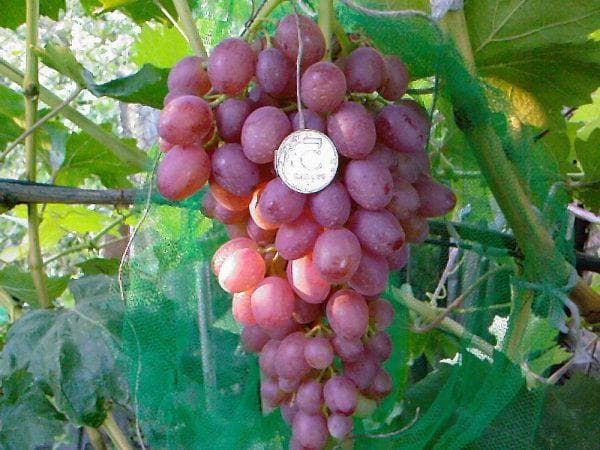

Cardinal
The variety was obtained by crossing two parental species: Queen Victoria and Alphonse Lavalle. Such noble ancestors could not help but "give birth" to an outstanding "offspring" - it became the variety "Cardinal".
This variety is a table variety of grapes, has very large berries, and the bunches themselves are also massive. So, the average length of one bunch in this case ranges from 19 to 28 cm, and its width is 13-19 cm.
Interestingly, the mass of bunches is not so great - it usually does not exceed half a kilogram. But experienced gardeners also grow bunches of 900 grams. The shape of the bunch is cylindrical-conical, strongly elongated at the bottom. The bunch is loose, loose, which explains its relatively low weight with a significant size.
The berries, as already mentioned, are large - one berry can be from 2.1 to 2.9 cm long. The weight of one fruit is 7-9 grams. The shape of the berry is elongated, oval. Fruit color is reddish-purple with a smoky bloom. The Cardinal has very tasty berries: tender, moderately sweet, with a slight nutmeg tint. The sugar content is low - 15-18%, but the acidity is also low - 7-9 g / liter. The pulp is greenish-white, very juicy and quite fleshy, with a consistency reminiscent of dense jelly. Inside there are 2-4 rather large bones. By clicking on the link you can find out about the features of growing Isabella grapes, as well as about the description of the variety.
The grapes of this variety are intended mainly for the preparation of high quality table wine. In addition, jam is often made from berries, jams are made, and delicious juice is prepared.Of course, this grape is also good fresh.
The variety belongs to early ripening - the berries reach maturity 121 days after opening the eyes: around the middle of August, you can already harvest. If the summer turned out to be cool, then the Cardinal may mature longer, but only slightly.
With proper agricultural technology, the shrub can bring the first harvest the next year after planting. But sometimes it begins to bear fruit in the third year - there is also nothing to worry about. But after the first fruiting, the yield will only increase every year.
The video shows a description of the Cardinal grape variety:
The advantages of this variety include its surprisingly long shelf life. Thanks to the dense skin, the berries can lie without signs of rotting for three months. This makes the cultivation of the Cardinal economically viable, since the berries can be transported over any distance without any problems.
Note that the variety is very thermophilic, therefore it is not suitable for cultivation in cold climatic zones.
Description of the variety, characteristics with photo
This grape variety is relatively young, not even a hundred years old. Bred in sunny California in 1939, after a while it crossed the ocean and spread to southern Europe - in France, Italy, Spain. It can be seen in the vineyards of Romania, Greece and Bulgaria. Cardinal is a thermophilic variety, and in the Soviet Union it first appeared on the territory of the Krasnodar Territory, Moldova, Crimea and southern regions of Ukraine. They brought him here from France in the post-war years.
The cardinal belongs to the table varieties, it has large, branched, cylindro-conical bunches with an average weight of 350 g to 500 g, but giant bunches weighing almost a kilogram can be found. The sugar content of juicy fleshy grapes of the Cardinal variety is 18%, the berries are oval purple-red, covered with a wax coating. The stones are large, few in number (2-4). The average weight of one berry is about 10 g.
The Cardinal grapes have a pleasant sweet taste with a nutmeg aftertaste and aroma. The consistency of the berries allows you to make almost everything from this grape:
You can make delicious and healthy sweets from grapes like marshmallow and churchkhela, you can pickle berries. But it can be stored for a long time and unprocessed up to three months under proper storage conditions. It can be transported without any significant losses due to the resistance of dense berries to damage (do not crumple, do not crush).
Bushes grow up to 3 meters high. The vine of this grape is bright brown in color, shiny leaves of a rounded shape are light green, with a brownish border, the edge is absent. With the onset of autumn, the leaves turn yellow.
The grapes of the Cardinal variety belong to the early ripening varieties: in the growing areas in Russia, ripe Cardinal bunches can be removed from the vine as early as mid-August, if the weather is favorable.
Mild weather is considered favorable for this variety, akin to that that prevails in Mediterranean countries. Under these conditions, the grape bunches ripen in four months. More than 150 centners of grapes can be harvested from one hectare.
How to plant and care for the Cardinal grape variety


Resistant grape variety Cardinal: photo
Resistant Cardinal grapes can be propagated in a variety of ways. It is best to use grafts and root the layers.
If you propagate grapes by cuttings, it is best to do this in the spring. In the spring, it is preferable to plant autumn cuttings, so they will strengthen well over the summer and adapt to a new place, which means that the plant will develop faster. But remember, keep the cuttings in a cool place.
A few words must be said about the choice of a place for planting grapes. Pay attention to the southern slopes, which are well lit by the sun.The Italian Cardinal grapes also do not like drafts. If we talk about the type of soil, then we note that grapes grow better on black soil. Do not plant this grape near plants that are also not disease resistant. The grapes love moisture, so it is necessary to water it regularly, but remember, an excess of water on the site leads to rotting of the fruit. In this case, it is best to build a drainage system. It is especially important to pay attention to watering during the formation of the ovary and flowers. Gardeners recommend mulching the topsoil in spring and autumn. This is done with sawdust, compost or humus. But remember, this very layer of mulch should be at least 5 cm in thickness. This is done in order to retain moisture, as well as to prevent the appearance of weeds on the site.
In order for the grapes to develop better, it recommends applying complex fertilizers to the soil before flowering. In the fall, organic matter is placed under the roots, so you will kill two birds with one stone, on the one hand, protect the root system from frost, and on the other, enrich the soil with useful substances and trace elements. Due to the fact that this grape variety is not resistant to diseases and pests, it is advisable to treat it with fungicides, sometimes this is done several times per season, regularly prune the vine, it is advisable to leave no more than 6 eyes on one shoot, and the grapes tolerate short pruning perfectly. Before the onset of frost, it is advisable to cover the grapes with straw, sawdust, so that the plants overwinter well.
Agricultural technology varieties
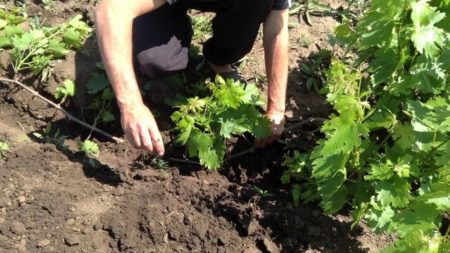

"Cardinal" is a demanding variety for growing conditions. It is recommended to plant it in regions where winters are mild, where there are no sharp fluctuations in temperature in spring. The ideal soil for grapes is black soil. On loamy and sandy loam soils, the yield of berry crops is significantly reduced.
Reproduction
The best option for propagating grapes, among all possible ones, is grafting cuttings onto the stock of another variety of berry culture. Vaccine recommended for resistant varieties such as Ifc X Berlandieri and Berlandieri X Riparia. Harvest grafting material in late autumn, when sap flow completely stops. Cut off the vines from the middle, where they are about 7-10 millimeters in diameter. At least 4 buds should remain on the handle. To keep the grafting material until spring, cover the ends with paraffin, wrap with paper, put in the refrigerator on the lower shelf or in the cellar.
Helpful advice!
To treat cuttings with paraffin, take two half liter jars. Fill one with cold water and the other with boiling water. Dip a thick paraffin candle into a container of boiling water. It should completely dissolve in the liquid. Take a cutting and dip it in the hot mixture with paraffin about 10 cm from the end, and then immediately in cold water. A paraffin film should form at the ends, which will protect the cutting.
Origin
Among the 10,000 grape varieties existing in the world, some of which are presented on our website, it is generally recognized stands out for the exceptional spectacularity of large berries, the color palette of red-purple tones, and inimitable light nutmeg aroma of crispy light green pulp. Muscat Hamburg, Pleven and Delight are close to him in taste.
He is a dear guest on the festive table, an exquisite snack for dessert wines, a source of health and endorphins - hormones of joy.
Its bright brown shoots and five-lobed shiny leaf seem to look at us from all the landscapes of the Mediterranean.
But the homeland of the variety was distant California in the twentieth century, the geographical latitude of which, even in comparison with Italy, is closer to the equator. Another spectacular guest of our gardens comes from California - the Witch's Fingers grape.
That's where this varietal masterpiece comes from warmth-loving nature and such vulnerability to adverse conditions: if it rains and gets slightly colder, gray rot appears on the leaves.
As the first person in the community of table varieties, he requires careful attention to himself and constant care, but all the difficulties of agricultural technology are paid off by the commercial presentation of the sun berry.
The size of the "Cardinal" berries reaches 40 mm in diameter. Such a berry cannot be eaten in one bite. Another representative of grapes with large berries is the Athos variety.
Variety characteristics
The Cardinal variety has both advantages and disadvantages.
Advantages:
- early ripening;
- high yield (up to 20-25 kg per 1 bush);
- can be stored for a long time without loss of quality;
- drought resistance;
- pleasant taste.
Disadvantages:
- poorly tolerates a drop in temperature during the growing season (shedding of the ovary and flowers may occur, the berries become smaller);
- the yield is unstable;
- non-simultaneous ripening of berries in bunches;
- weak winter hardiness;
- poor resistance to diseases and pests;
- exactingness to soil quality and care (yield may fluctuate).
"Cardinal" varieties
"Cardinal" is a grape variety that breeders are constantly working on. On the basis of the basic one, new varieties have now been developed, differing from each other in specific features:
- "Cardinal Lux" ("Cardinal" + "Criulyansky") is a variety that is more resistant to cold and disease. Medium early - ripening period 115-125 days
- Rochefort (Cardinal + Talisman) is the ancestor of other varieties. Early - ripening period 105-110 days
- "AZOS" (own "Cardinal", which was bred in Anapa) - is distinguished by increased, more persistent performance. Medium early - ripens in 120-130 days.
Care features
Once again, we note that the plant is quite capricious, and thorough care will be required. Otherwise, high yields are most likely not to be expected. What points of care must be observed when growing Cardinal grapes in the garden.
Watering
Like all other grape varieties, Cardinal is very fond of moisture. However, when watering a shrub, it is important not to overdo it, since an excess of water in this case is no less harmful than a lack of it. It happens that the berries lose their quality properties, cracking due to too much watering, and besides, their taste becomes too watery.
Watering the vine 2-3 times per season is considered optimal. The first mandatory watering is before flowering, the second mandatory - after flowering. And the third time depends on the local climate: in arid conditions, additional watering is necessary, and if the summer is rainy, then there is no need to water anymore. Read about the rules of caring for Augustine grapes here.
If your climate is damp, it is best to equip your vineyard with drainage systems to help drain excess moisture.
Top dressing
Cardinal grapes are very fond of competent feeding, and responds to them with increased growth and increased productivity. Since the berries of the plant are large, and there are many of them, it needs sufficient nutrients: it is necessary to provide the shrub with them.
Among other things, fertilizing helps the plant to resist diseases, fungi and infections. Of all fertilizers, Cardinal prefers potash-phosphorus formulations. But organics are also useful to him. And here is how planting and caring for Aleshenkin grapes occurs here.
The video shows how to care for grapes:
As for mulching, this procedure is also very desirable for a shrub. It is necessary to mulch the grapes along the root circle, using a humus layer of 3 cm. The procedure is recommended to be carried out twice a season: in spring and autumn.
It will also be interesting to know more about the description of the Rapture grapes.
It is also worth seeing what the Arcadia grape variety looks like, as well as what are the features of their cultivation.
Wintering
In order for a thermophilic plant to winter safely in our difficult climate, even if you live in the south of Russia, it must be covered before the cold weather.
It is imperative to cover the root circle, using hay or straw for this. The protective layer is laid on the ground, together with the mulch layer, trying to grip the trunk as high as possible. It is advisable to put the vine on the ground, and also cover it according to the previous principle.
Young animals require especially careful shelter: you can even use a solid protection in the form of a large wooden vessel with a carved bottom for this.
The video shows how the grapes are wintering:
In addition to winter cold, spring frosts are also dangerous for branches, especially if you have already managed to remove the protective shelter. Since the grapes of this variety begin to bloom early, night return frosts can kill the entire crop in the vineyard. Tip: If the climate in your area is capable of such surprises, do not open the bush too early in the spring. This material will tell you about the description of the grape variety in Moldova.
Pruning
This procedure is necessary, as it allows you to form a bush, and at the same time to remove excess flower stalks, protecting the bush from being weighed down by too many bunches.


Pruning grapes
If the bush is of medium size, then when pruning, leave no more than 25-30 eyes on it, if the bush is large, you can leave more. A sufficient number of shoots - 13-16: leave the strongest and strongest, cut the rest. It is advisable to carry out the procedure in the fall, so that in the spring the plant is no longer disturbed before the growing season.
Testimonials
We will find out what opinions of experienced gardeners who grow it have about this grape variety.
- Ksenia, 46 years old, Volgograd: “I have been growing grapes on my site for a long time: we live in the south, so this is not surprising. I like to try different varieties, but I looked closely at the Cardinal for a long time: he was embarrassed by his capriciousness and exactingness in care. But I decided to try - and nothing, I did it. And now caring for him does not cause any trouble for me - everything is automatic. But every year he pleases me with a high harvest, and very tasty berries. All neighbors are surprised at the size of the bunches and the berries themselves. I am happy, but I recommend growing the cardinal only in warm climates, as it is not intended for cold winters. "
- Oleg, 35 years old, Penza: “Although I live in a region with not the warmest climate, however, I grow grapes. My varieties are mostly frost-resistant, I did not contact the thermophilic ones, as I thought they would not take root. However, it turned out that he acquired several cuttings of the Cardinal - he decided to plant it for the sake of experiment. I planted it in the spring, it was already warm, the cuttings took root quickly. They grew remarkably in the summer, and I covered them well for the winter. And next spring I expected to see frozen branches, but the plants survived, and this summer they were already bearing fruit. Now I already have strong shrubs, they give a wonderful harvest every year. Very tasty berries, large, juicy: I make wine from them, my wife makes jams, I sell the surplus. I recommend this variety: with good shelter for the winter, it can grow even in regions with a cool climate: tested in practice. "
It is also worth learning more about the reviews and about the description of the Lydia grape variety, for this you should follow this link.
We examined the features of the Cardinal grape variety. As you can see, this representative of the grape family has a lot of valuable advantages. Productivity and great taste of the fruit make this variety one of the most popular in modern horticulture. And if you want to acquire a grape variety capable of producing high quality berries every year, and in large quantities, pay attention to Cardinal.

